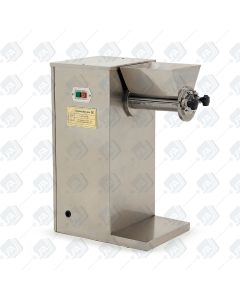Una granuladora de mezcla rápida es una mezcladora/procesadora multipropósito adecuada tanto como para la dispersión a alta velocidad de polvos secos (incluyendo polvos efervescentes), como para su granulación con disolventes acuosos u orgánicos. El equipo está diseñado para lograr una mezcla rápida y la formación de gránulos consistentes necesarios para la producción de tabletas de alta calidad farmacéutica para métodos de dosificación de medicamentos sólidos. Una buena mezcla y control del tamaño de los gránulos permite una gran velocidad de comprimidos y productos de alta calidad con un bajo índice de rechazo.
Different Wire Mesh Sizes And Its Conversions
In the pharmaceutical industry, sieves and screens are regularly used to determine the size of raw materials. The most common way to measure the sieves and screens is with meshes. On average, about 40 to 400 sieves are used in the industry, especially during the milling and sifting of raw materials.
Getting the mesh size correct for your particular blend is really critical. It will determine how the excipients mix together during the mixing process, how the dry lubricants and anti-caking agents react with the binders and, ultimately, how the mix presses in the tablet or pill press that you are using.
A mesh shows the available opening in one linear inch of a screen or sieve; a 10-mesh sieve has 10 openings, whilst, a 300-mesh sieve will have 300 available openings in a linear inch. The fineness of the screen or sieve will depend on the wire width. A wire that is used for a 10-mesh sieve is thicker than one that is used for a 60-mesh sieve;, a thin wire will not work for a thick sieve and a thick wire won’t be used to make a fine sieve.
For a material to have fine particles, it is important to use a fine sieve with small openings. To determine the fineness of the sieve, one should take into consideration the size of the mesh. When the mesh size increases and the pore decreases, the fineness of the sieve increases.
Conversion Table for Mesh to Microns and Inches
| U.S. MESH | MICRONS | INCHES | MILIMETERS |
|---|---|---|---|
| 3 | 6730 | 0.2650 | 6.730 |
| 4 | 4760 | 0.1870 | 4.730 |
| 5 | 4000 | 0.1570 | 4.000 |
| 6 | 3360 | 0.1320 | 3.360 |
| 7 | 2830 | 0.1110 | 2.830 |
| 8 | 2380 | 0.0937 | 2.380 |
| 10 | 2000 | 0.0787 | 2.000 |
| 12 | 1680 | 0.0661 | 1.680 |
| 14 | 1410 | 0.0555 | 1.410 |
| 16 | 1190 | 0.0469 | 1.190 |
| 18 | 1000 | 0.0394 | 1.000 |
| 20 | 841 | 0.0331 | 0.841 |
| 25 | 707 | 0.0280 | 0.707 |
| 30 | 595 | 0.0232 | 0.595 |
| 35 | 500 | 0.0197 | 0.500 |
| 40 | 400 | 0.0165 | 0.400 |
| 45 | 354 | 0.0138 | 0.354 |
| 50 | 297 | 0.0117 | 0.297 |
| 60 | 250 | 0.0098 | 0.250 |
| 70 | 210 | 0.083 | 0.210 |
| 80 | 177 | 0.0070 | 0.177 |
| 100 | 149 | 0.0059 | 0.149 |
| 120 | 125 | 0.0049 | 0.125 |
| 140 | 105 | 0.0041 | 0.105 |
| 170 | 88 | 0.0035 | 0.088 |
| 200 | 74 | 0.0029 | 0.074 |
| 230 | 63 | 0.0024 | 0.063 |
| 270 | 53 | 0.0021 | 0.053 |
| 325 | 44 | 0.0017 | 0.044 |
| 400 | 37 | 0.0015 | 0.037 |
There is no standard formula to convert mesh to micron and vice-versa. Below is a conversion formula that might help to provide an approximate value on the conversion of the mesh to micron and vice-versa.
Mesh x Micron = 14900 (Approximate)
Micron = 14900/Mesh or
Mesh = 14900/Micron
As this is only an estimate, remember to leave room for error. The formula is helpful if one wants to have an approximate value for 50 to 400 mesh.
Follow this formula for converting mesh and inch:
Inch= 0/6/mesh
Mesh = 0.6/inch
| Mesh Size | Micron | % Variation from Original | |
|---|---|---|---|
| Original | Calculated | ||
| 50 | 297 | 297 | 0.3 |
| 60 | 250 | 248.3 | -0.7 |
| 70 | 210 | 212.8 | 1.3 |
| 80 | 177 | 186 | 5.1 |
| 100 | 149 | 149 | 0.0 |
| 120 | 125 | 124 | -0.8 |
| 140 | 105 | 106 | 1.0 |
| 170 | 88 | 88 | 0.0 |
| 200 | 74 | 74.5 | 0.7 |
| 230 | 63 | 64.7 | 2.7 |
| 270 | 53 | 55.1 | 4.0 |
| 325 | 44 | 45.8 | 4.1 |
| 400 | 37 | 37.25 | 0.7 |
Suscríbase a nuestro boletín de noticias
Determining the Mesh Size of Different Screen Size
To obtain the mesh size of any screen type, follow these simple steps:
- Mark the sieve about 1 inch using a marker and a scale
- To be more accurate, start measuring from the center of the wire
- Start counting the holes in one linear inch
Example: if there were 40 holes in one linear inch, it would be 40-mesh in the sieve.




